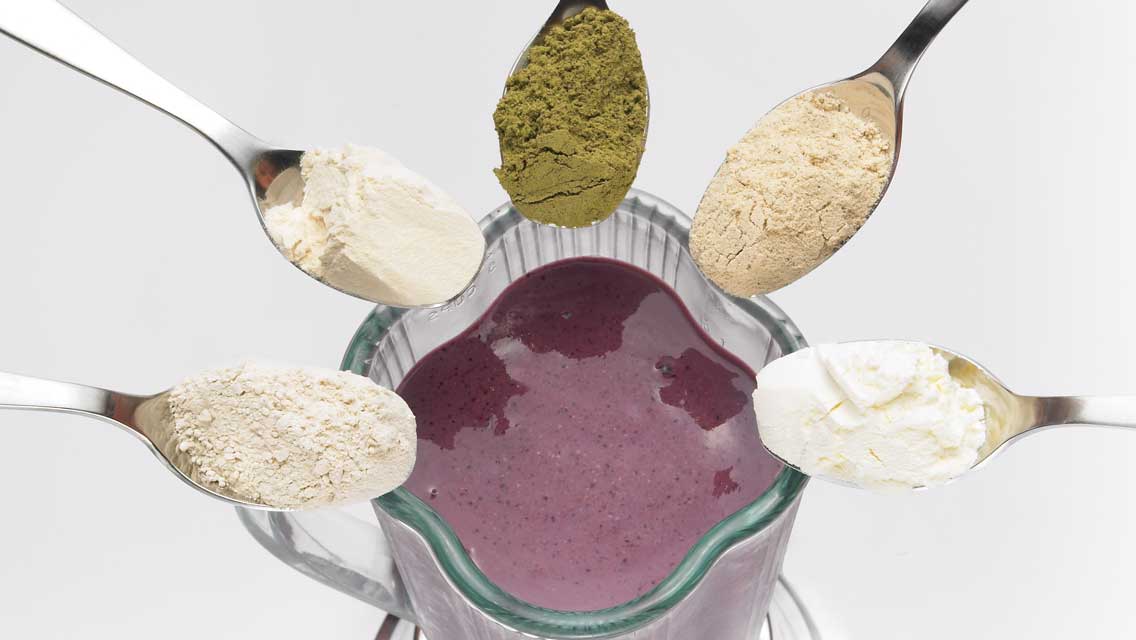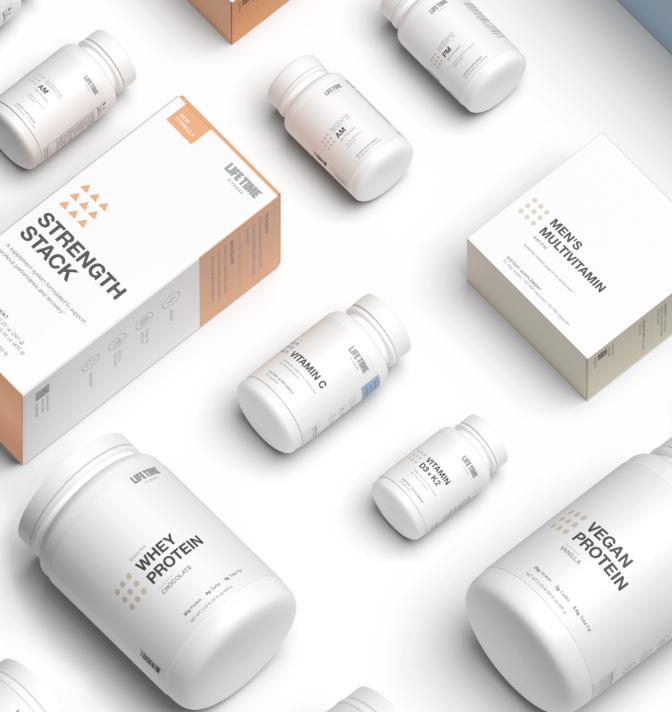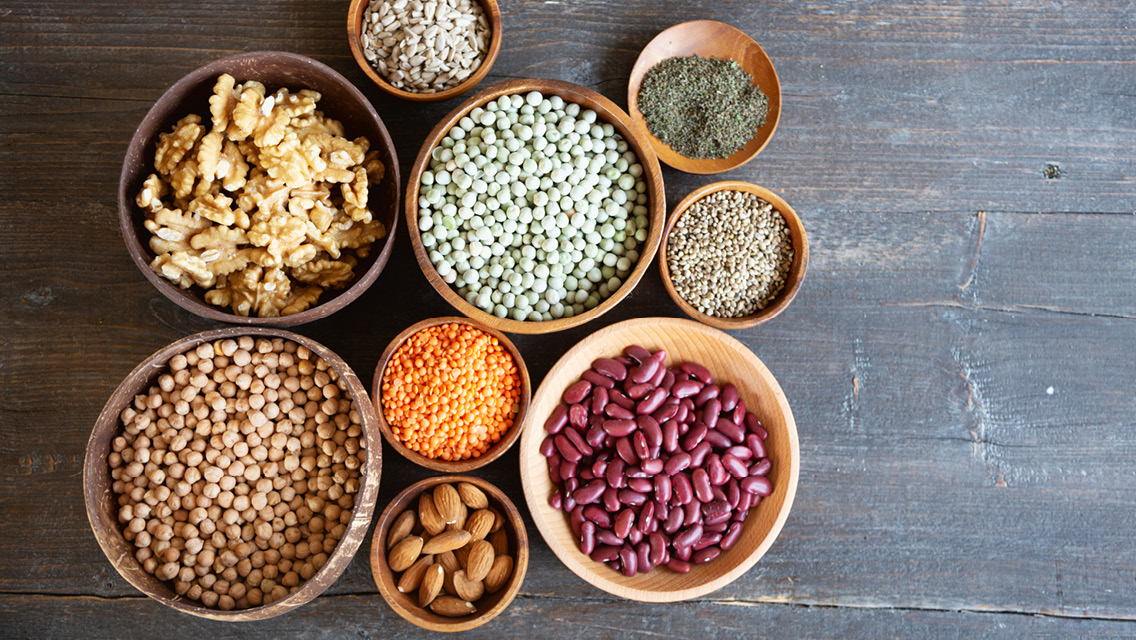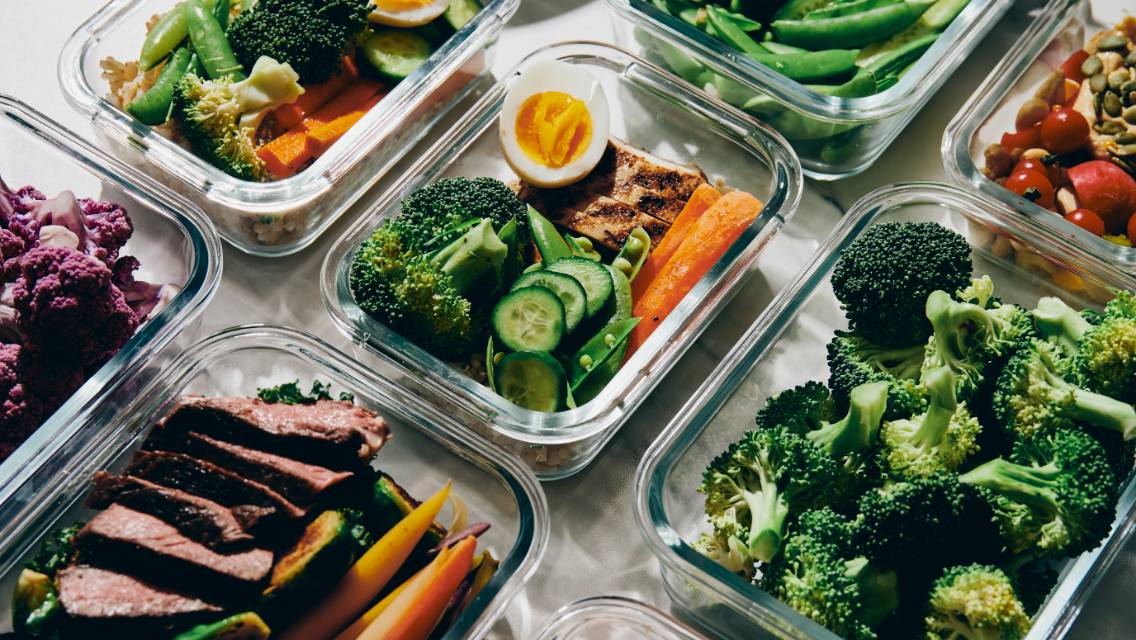Explore this article:
- Protein Primer
- The Role of Protein Powder in a Whole-Foods Diet
- Two Types of Protein Powder
- Finding the Right Protein Powder
- How to Build a Smoothie
- Recipe: Berry Blast SuperShake
- Recipe: Ginger Pear Smoothie
Protein powders are one of the most popular supplements around. Athletes and bodybuilders have long used them as a convenient way to feed their postworkout needs. Even high-profile television shows like The Biggest Loser have made daily protein supplements seem de rigeur for anyone trying to lose weight and get in shape. But for the ordinary person trying to fit a regular workout into a busy schedule, is protein powder worth a try?
While the popular types of protein powder — whey, casein, egg, soy, hemp, rice and pea — provide concentrated sources of protein, many experts say we can easily get all the protein we need from high-quality sources such as fish, lean red meats and poultry, eggs, beans and legumes, and dairy products.
“Keep in mind, people on shows like The Biggest Loser have trainers who are after them all day long, and they’re working out an inordinate amount of time,” says Liz Applegate, PhD, director of sports nutrition at University of California, Davis. “It’s not practical to directly apply everything they’re doing to our lives,” she says.
You have to ask yourself where protein fits into your life with your eating and your exercise habits, says Applegate. When, how much and how hard do you work out? Perhaps you work full-time in an office or go to school all day and have trouble getting protein at the right times in the proper amounts throughout the day. Based on your individual daily habits, you need to decide what makes sense for you.
That said, Applegate often recommends starting the day with a fruit smoothie that has protein powder added (see “How to Build a Smoothie,” below). “If you don’t eat eggs in the morning, for example, or you don’t have time to make a protein-packed sandwich for your lunch, or when you come home from work and just nibble on crackers and fruit — you may have difficulty getting enough protein during the day,” she says.
It’s not all hype, says James LaValle, RPh, CCN, MS, founder of the LaValle Metabolic Institute, an interdisciplinary healthcare facility in Cincinnati, Ohio. The average person is working out a lot harder than people once did, and you need protein to replenish muscle tissue after you exercise. You could satisfy that need with a piece of grilled chicken, an egg salad sandwich or some three-bean chili. But a protein drink might be quicker and more convenient.
Before jumping on the protein-powder bandwagon, however, it helps to take a look at why we need protein, as well as the potential benefits and drawbacks of protein powder itself.
Protein Primer
Your body needs protein for survival. Amino acids — the building blocks of protein — are necessary for everything from immune function, metabolism and weight management to muscle repair, growth, development and performance. There’s also research that shows protein helps you feel alert, says Applegate, as well as more satiated for a longer period of time.
How much protein you need each day is highly individual and varies depending on your activity level and fitness goals. That said, the average healthy person needs 0.8 to 1 gram of protein per kilogram of body weight to prevent deficiency. (A kilogram is equal to about 2.2 pounds, so a person weighing 150 pounds would need about 55 to 68 grams of protein each day.)
How much protein you need each day is highly individual and varies depending on your activity level and fitness goals.
Athletes need more, depending on the duration and intensity of exercise and frequency. “So, if you’re strength training every day, you need 1.4 to 1.8 grams per kilogram,” says Sarah Feasel, MEd, RD, LD, CNSC, clinical nutrition manager at National Rehabilitation Hospital in Washington, D.C. Endurance runners need 1.2 to 1.4 grams per kilogram.
It’s best to pace your protein intake throughout the day (this makes it easier for your body to digest and metabolize the protein). If your goal is to build muscle, boost athletic performance and decrease workout fatigue, eating some protein within an hour after a hard workout can help refuel and repair muscle tissue.
The Role of Protein Powder in a Whole-Foods Diet
Protein powders are designed to augment your overall daily protein intake. They are convenient, they can digest faster than whole-foods sources of protein, and they can boost the overall protein content of real foods without significantly raising their total calories or carbohydrates. Whether protein powder belongs in a healthy eating plan, however, really depends on the person and situation, says John Berardi, PhD, CSCS, founder and chief scientific officer of Precision Nutrition Inc., a nutrition education and information company based in Toronto, Canada.
“Protein powder is a highly refined food — everything has been taken out of it except the protein,” he says. With soy powder, for example, you miss out on the fiber and some phytonutrients. With whey, you miss other nutrients that come in milk, like calcium. Today’s protein-powder products often come fortified with some of these nutrients, but that doesn’t make them whole foods.
“Protein powder is a highly refined food — everything has been taken out of it except the protein.”
“Mother Nature puts an array of nutrients in whole foods for us to consume,” explains Applegate. “When we isolate out compounds like protein, we may miss the synergies or interactions that occur between all the compounds found naturally in those foods.”
Also, protein powders are not regulated by the FDA. “They have the G.R.A.S. rating (Generally Recognized as Safe), but you don’t always know exactly what you’re getting with these products,” says Feasel.
Even when you follow the instructions on the labels, you can easily consume too much, Feasel adds: “The labels on some products suggest amounts that can add up to as much as 120 percent of your recommended daily value” — one reason experts don’t recommend protein powder for children without a doctor’s supervision.
Even when you follow the instructions on the labels, you can easily consume too much.
Adults should also check with their doctors before ingesting protein powder if they suffer from any conditions that would warrant medical supervision, or if they’re taking medications that would be compromised by excessive amounts of protein. But as a healthy adult, adding 20 grams of protein to your diet after a workout should not require medical supervision, says Applegate.
Research is inconclusive on the health effects of consuming too much or too little protein. “Over time, however, too much protein could worsen any problems you’re already having with your kidneys and bones,” says Feasel, who finds that older people or those with underlying health conditions are more likely to suffer these consequences.
“Over time, however, too much protein could worsen any problems you’re already having with your kidneys and bones.”
Yet, if you do work out regularly or have trouble finding convenient sources of protein, you might benefit from protein powders. But make sure that you don’t get dehydrated. “When you increase protein, you must increase fluids so that your body can help flush out toxins, such as uric acid, which are caused by extra protein,” says Feasel.
Some protein powders may be difficult to digest, while others can cause allergic reactions. If you are allergic to milk products, for example, you may also be allergic to a milk-based protein powder, although some whey protein is mostly lactose-free.
Some people worry that consuming high amounts of protein makes you acidic. But that’s not a problem as long as you include fruits and vegetables as a regular part of your diet, says LaValle. “The research shows it’s only when people go on a severe high-protein, low-carb diet that high acidity and increased risk of kidney stones occur.”
Protein powders certainly are convenient, and although they may not be right for everyone, they can be beneficial as a supplement to a whole-foods diet.
2 Types of Protein Powder
The common types of protein powders fall into two categories:
- Animal-based (casein, whey and egg)
- Plant-based (soy, hemp, rice and pea)
The animal-based protein powders and soy and hemp are complete proteins, meaning they contain all nine essential amino acids that people need every day. Egg protein powder is popular with weightlifters because it’s the most complete protein you can get. “We often call it a ‘perfect protein,’ meaning the protein matches up quite closely to what we need,” says Applegate. If you’re a vegetarian, your best choice is hemp or soy protein powder.
If you opt for one of the other plant-based protein powders, you can always blend it with another protein powder to make sure you’re getting all the amino acids you need.
In terms of digestibility, it’s all about trial and error, says Berardi. You can try different types and brands, alternate, or even mix types and see what works best for your purposes (in fact, one of the most popular protein-powder types is a milk blend that is 80 percent casein and 20 percent whey). “If you want to gain muscle or lose fat,” he says, “splitting hairs with protein-powder type is the least of your concerns.”
“If you want to gain muscle or lose fat, splitting hairs with protein-powder type is the least of your concerns.”
What’s more important is to be aware of the other ingredients in the powder supplement besides protein. For example, avoid artificial sweeteners and preservatives. “If you don’t recognize an ingredient on your protein-powder label, you might want to find a different one,” says Berardi.
Also, make sure the actual amount of protein in the supplement is significant and meets your individual needs. Stay away from hydrolyzed animal protein if that’s listed on the label, warns Applegate, because it’s very poor-quality protein from animals, like gristle or connective tissue, for example, and is not as digestible.
“There is no doubt that taste, dissolvability and ease of use is all over the board with protein powders,” says LaValle. Some will taste chalky, others won’t. Some you can dissolve in a glass of water with a few stirs, others need to be mixed at high speeds in a blender. Some have fibers added, which slows down the transit time; that can be beneficial if you’re using it as a meal replacement, but not when you need a quick hit after your workout.
The best protein powder after a workout is one that gets the amino acids into your bloodstream quickly to stimulate insulin release, says LaValle. The insulin carries the protein to your muscles to help you recover from the exercise. (See “Finding the Right Protein Powder,” below, for more info.)
The best protein powder after a workout is one that gets the amino acids into your bloodstream quickly to stimulate insulin release.
If you’re going to make protein powder a part of your nutritional regimen, invest in one or more good-tasting products that dissolve completely when mixed with other ingredients — like fresh berries, green tea, greens powder and nuts. You’ll find that when it comes to protein, good quality is worth paying for.
As with all supplements, though, even the best protein powders are designed to boost a healthy, balanced whole-foods eating plan, not to be a mainstay source of nutrition. You might try having a protein shake in the morning or as a midafternoon snack. On big workout days, mix up a protein drink on your way out the door. Just keep on sitting down for your share of solid meals, too.
Finding the Right Protein Powder
Wondering which protein powder to toss into your next smoothie? Here’s what you need to know.
First, keep in mind that characteristics like taste, texture and digestibility are highly individual; you might have to search a bit to find your perfect powder. You may also want to experiment with different powders for different purposes (all-day energy vs. pre- or post-workout boost).
When it comes to gauging energy release, note that anything you add to your protein drink will influence its speed of digestion. For example, ingredients with fat, fiber or additional protein, such as nuts and seeds, are likely to slow digestion of the smoothie (giving it a slower-burn effect), while anything with sugars or simple carbohydrates, such as fruit, is likely to speed up digestion (creating a faster initial energy boost).
Below you’ll find an at-a-glance look at the most popular types of protein powder. (And, remember, you can always blend different powders to achieve your ideal result.)
For This Use |
Try These Proteins |
| On waking | Whey, rice or pea |
| Before a workout | Whey, rice or pea |
| After a workout | Whey, rice or pea |
| Before bed | Casein, egg, soy or hemp |
| Between meals | Casein, egg, soy or hemp |
Protein Pros
- Casein: high amounts of the amino acid glutamine
- Whey: may strengthen immune system response
- Egg: concentrated amounts of essential amino acids
- Soy: may have benefits for cardiovascular disease
- Hemp: provides omega-3 fats; most forms provide fiber; available in raw form
- Rice: neutral taste, economical
- Pea: highly digestible, economical
How to Build a Smoothie
Theoretically, there are innumerable smoothie combinations, but the basic components to most smoothies involve:
- One or more liquids (water/ice, tea, diluted juice, etc.)
- Yogurt
- Fruit
- And, if you like, a protein powder of your choice
From there, you can toss in any number of extras, such as:
- Nuts
- Supergrains
- Ground flaxseed
- Coconut flakes
- Other supplements
- Handful of raw spinach
Below are two smoothie recipes, one from John Berardi, PhD, CSCS, founder and chief scientific officer of Precision Nutrition Inc., a nutrition education and information company based in Toronto, Canada, and one from Brendan Brazier, Ironman triathlete and author of Thrive: The Vegan Nutrition Guide to Optimal Performance in Sports and Life, from which the recipe is taken.
Feel free to craft your own smoothie concoction at home. All you need is a good blender and a little imagination!
Berry Blast SuperShake
Makes 1 serving
Recipe by John Berardi, PhD, CSCS
Ingredients
- 1 cup green tea
- 1 scoop vanilla-flavored protein powder
- 1 serving of greens supplement
- 3 tbs. plain yogurt
- 3 tbs. whole-grain oatmeal (dry)
- 1 cup frozen mixed berries
- 1 tbs. raw mixed nuts
Directions
- Add your green tea, vanilla flavored protein powder, greens supplement, plain yogurt and whole-grain oatmeal to a blender and blend on high for one minute.
- Next, add fresh berries and mixed nuts to the blender and blend again for one minute.
Ginger Pear Smoothie
Makes 2 servings
Recipe by Brendan Brazier
Ingredients
- 1 banana
- 1/2 pear, cored
- 2 cups cold water
- 1 tbs. ground flaxseed
- 1 tbs. hemp protein
- 1 tbs. grated ginger
Directions
- Simply blend together in a blender and enjoy!





This Post Has 2 Comments
In terms of protein powder consumption, and the chemical makeup of various protein sources, I thought it was very informative. Whether you are a longtime protein powder user or just starting out, this is one of the best articles I have read.
This is the most straightforward, unbiased factual article on protein I’ve ever seen. Kudos on a thorough but concise presentation. Helped a LOT.